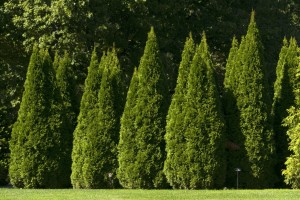Tip of the Week: Green Screen Options
Posted in Gardening Tips on October 5 2009, by Sonia Uyterhoeven
 |
Sonia Uyterhoeven is Gardener for Public Education. Join her each weekend for home gardening demonstrations on a variety of topics in the Home Gardening Center. |
 In the world of garden design there is the concept of a borrowed landscape: If life offers you a beautiful vista of valleys, mountains, or the ocean, by all means use it to your advantage and invite the natural beauty of the adjacent landscape into your own garden.
In the world of garden design there is the concept of a borrowed landscape: If life offers you a beautiful vista of valleys, mountains, or the ocean, by all means use it to your advantage and invite the natural beauty of the adjacent landscape into your own garden.
Most people, however, have the opposite problem when it comes to their backyards. More often than not it is a noisy street; an unsightly neighbor; or an ugly fence that needs hiding rather than highlighting.
A natural screen of evergreens buffers the sound of traffic while providing a nice visual barrier year round. In the past, homeowners would reach for the fastest growing evergreen, Leyland cypress (x Cupressocyparis leylandii), and watch it shoot upward beyond control. While this works for some, for others a row of green soldiers reaching up to the sky is not appealing. Fortunately, there are options.
I recommend this Thuja Green Giant tree an Eastern arborvitae (Thuja occidentalis, cultivar ‘Smaragd’, pictured above) is a readily available source, though it has a reputation of being “deer candy.” Instead, try the western (Thuja plicata) or the oriental arborvitae (Thuja orientalis). A good cultivar of the western arborvitae for a large screen is Thuja plicata ‘Green Giant’ and the improved ‘Steeplechase’. If you don’t have a deer problem, try the columnar eastern arborvitae Thuja occidentalis ‘Degroot’s Spire’.
If deer are regular visitors, try planting eastern red cedars (Juniperus virginiana). This tough, native evergreen grows in a wide range of conditions and provides birds with food and shelter. ‘Emerald Sentinel’ and ‘Canaertii’ are two of a number of good cultivars on the market. Another good candidate that retains its lower branches and handles part shade is Japanese cedar (Cryptomeria japonica). A good cultivar is ‘Yoshino’.
When planting a screen, rather than planting in a straight row, stagger the trees to create a natural appearance. Instead of planting a monoculture, which creates a flat look, mix it up and add broad-leaved evergreens and flowering trees.
Over the past decade the market has been flooded with cold-hardy hybrid camellias (Camellia). Cultivars such as Camellia ‘Survivor’ start flowering in early winter, while many of the late fall-flowering varieties such as ‘Ashton’s Pink’ and ‘Winter’s Moonlight’ carry the gardener through the winter months until the spring-blooming cold-hardy hybrids such as ‘Pink Icicle’ start to flower.
American holly (Ilex opaca) has proven to be more deer resistant than most hollies, generally doesn’t suffer from pest or disease problems, and can handle shade better then most evergreens. The females produce the beautiful berries (technically a drupe); a male is required for pollination. American holly does well in multiples and offers the bonus of sustaining over-wintering birds, which like to snack on the fruit once it softens.
Flowering trees and shrubs are a welcome addition to screens, as the evergreen foliage makes a lovely backdrop to the flowers. Woody plants with ornamental bark similarly look their best when planted in a dark screen. The coral bark maple (Acer palmatum ‘Sango Kaku’) and the red osier dogwood (Cornus sericea) are two candidates.
When creating a screen, approach it as a design project rather than as erecting a living wall. The design should incorporate different seasons of interests, different textures, and graduated heights. Begin with a colorful mix of flowering and evergreen shrubs and add larger specimens behind to create height. Finding ways to combine aesthetics and functionality lies at the heart of gardening.

